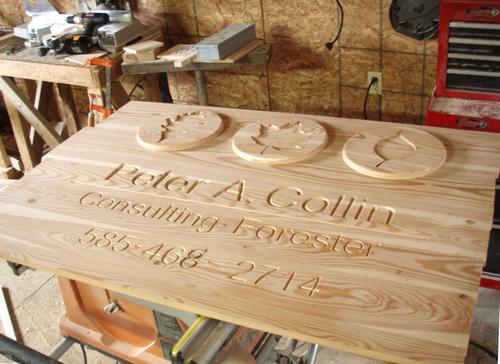 Thank you for offering your design plans for sale. I was originally
going to attempt this with the pantograph. It would have been much
trickier with that device!
Thank you for offering your design plans for sale. I was originally
going to attempt this with the pantograph. It would have been much
trickier with that device!
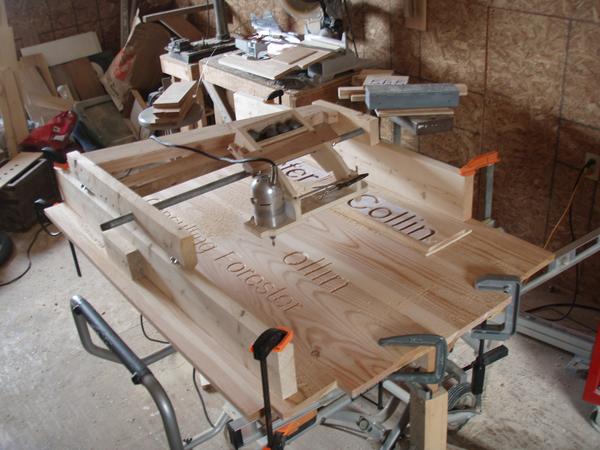 Peter Collin writes:
Peter Collin writes:
Hello Matthias,
I bought your router copier plans last spring with a specific project in mind. The sign I have out front for my forestry business is getting a bit old, and I wanted a snazzier replacement with some 3D lettering. My larch lumber was finally dry enough to give it a go.
The actual routing is the easy part. It is painstaking scrolling out all the lettering templates, but it is worth it as the sign is being routed front and back. Notice how I clamped the carriage near the follower. This really helped me get a consistent trace, more like I was using your pantograph. I also clamped the panel flat to a carpenter's level because my shop has wood heat. Going from 20 degrees F to 70, the larch wants to cup a little in places.
If I had it to do over again, I would have built the copy carver frame and rails longer, specific to the size of the sign so I wouldn't have to reposition the rails so often.
 Thank you for offering your design plans for sale. I was originally
going to attempt this with the pantograph. It would have been much
trickier with that device!
Thank you for offering your design plans for sale. I was originally
going to attempt this with the pantograph. It would have been much
trickier with that device!
Yours in New York,
Peter Collin
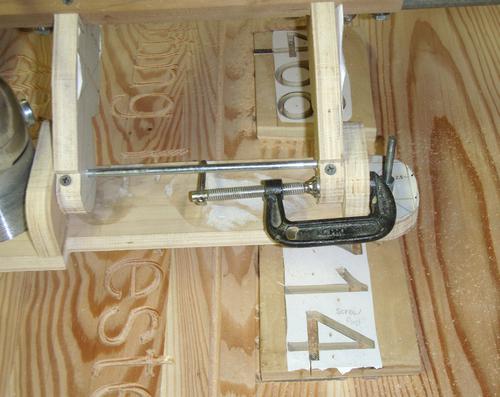 A close-up of the clamp I put on the carriage to make
for more consistent routing of the letters.
A close-up of the clamp I put on the carriage to make
for more consistent routing of the letters.
Matthias comments:
This effectively removes one degree of freedom, which eliminates the need for precise calibration of the mechanism. There will be some variation in tilt across the 6 mm variation in depth, but not enough to be noticeable from looking at it. A clever trick for sign carving with this copy carver!
I hadn't thought of putting the template on top of the sign in segments either, but with the tilt locked, that is workable. For signs, it may be better to lower the two rails to bring the metal pipe (pivot) closer to the surface. It's only this high to deal with taller objects, like when I carved the rotary phone.
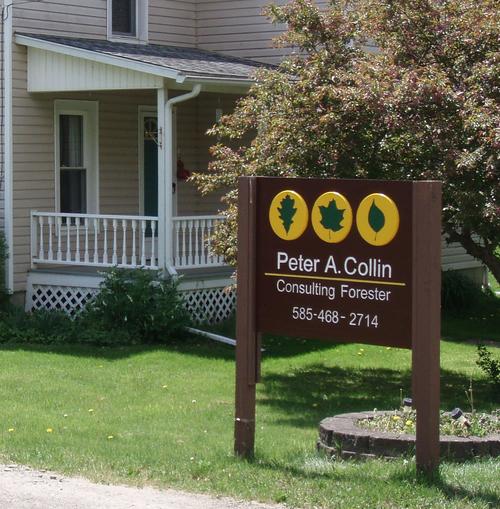 Peter Collin later commented about his experience:
Peter Collin later commented about his experience:
About 10 years ago I got a price from a professional sign maker of $900 to make this design - but out of redwood. That seemed steep, but I now appreciate the work it took to make it. Back then, I went with a cheaper one made of painted marine plywood that cost $350. In the new sign, I spent about $15 for the green larch lumber, which I air-dried. The paint will be about $35.
If I were to offer advice for any of your customers who bought the router copier plans for sign making, I would say to check your depth of cut frequently if you aren't cutting into plywood. The larch wanted to cup when my shop went from unheated to heated (by wood stove). I wanted to think I could set the jig and template and carve away, but the surface of the larch undulated enough that the cut depth was inconsistent in places.
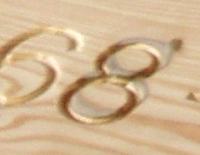 Be very careful when mounting the rails and template. Both must be
level with the lettering. If you mess up, make a mixture of epoxy
and sawdust, fill it in, sand, and try again.
(Look at my number "8" in
the picture. That was my most egregious error.) If you are painting
the sign, none of that will matter.
Be very careful when mounting the rails and template. Both must be
level with the lettering. If you mess up, make a mixture of epoxy
and sawdust, fill it in, sand, and try again.
(Look at my number "8" in
the picture. That was my most egregious error.) If you are painting
the sign, none of that will matter.
The carving of letters seems to require more precision than carving a phone or wrench. I didn't get a clean enough copy of the lettering to use the "paint-then-plane" method you did on your father's grave marker. Rather, when I paint the sign I can straighten any chattered edges with the contrast of pigments. A sharp cutter is mandatory to reduce the chattering. I wanted to buy a half inch V-groove bit to fit my widest letters, but the store was all out. Probably would have given better results.
As I mentioned, I should have made the frame and rails wide and long enough so it required only one setup on each side. Changing the position of the rails is how I got some of my mistakes. It might also be advisable for a sign maker to change the design of the carriage so the follower and router are as close together as the biggest letters allow. I was getting some flexing between the two, I believe, when the bit chattered. A shorter distance might lessen that. It would also reduce the amount of space you need for the templates. Keep the counterweight box the same size, though. I was using lead weights and had to fill it right to the top to get a balance.
Matthias comments:
Your router looks bigger than the one I used
Thinking back to that sign maker's fee, I wonder if this could become a nice little side-job? Will have to see how the larch withstands the weather first. I don't want to have to buy redwood!
Peter Collin
Peter Collin's YouTube channel